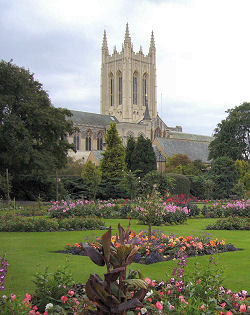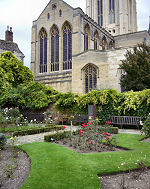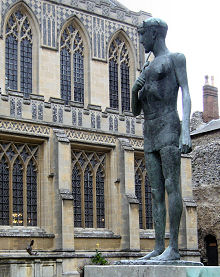



Abbey Gardens
The park is open from 7.30am until dusk Monday to Saturday and from 9am until dusk on Sundays.
Abbey Gardens Green Flag Winner
Abbey Gardens webcam - focusing on:
the flower beds - 8am to noon; and
the flower beds(close up) - 2pm to 8am.
View a map of Bury St Edmunds showing the Abbey Gardens (Multimap)
To locate the Abbey Gardens put IP33 1XL in your satellite navigation system.
Facilities
History
Sensory garden
Pilgrim's herb garden
Central area
The riverside
Trees and shrubs
Appleby Rose Garden
Water garden
Carpet bedding
Wildlife feeding area
Facilities
Aviary
Varieties of birds include canaries, budgies, teal ducks, Bengalese and Zebra finches and diamond doves.
Bowling green
Tickets for bowling are available from the Park Keeper’s office.
Bowling is available from April to October.
Charges from 1 April 2010 are as follows:
Adults: £3.15 per person per game
Children (under 17 years of age and accompanied by an adult): £1.80 per child per game
Off Peak (Monday to Friday, excluding public holidays, between the hours of 12 noon and 2.30pm): £2 per person per game
Hire of Bowls: £1.15 and £1 deposit per set of four
Hire of Jacks: 65p and £2 deposit per jack
If you would like to make a group booking please call 01284 757490.
Kiosk
This is located near the aviaries and sells ice creams and light refreshments.
Play area
The fenced area is designed for children up to seven years old and the other equipment is for mixed ages.
The key for the Wheelchair Swing is available from the Park Keeper's office.
Putting green
This is available for hire between 9.30am and dusk.
Putting is available from April to October and is weather dependant.
Tickets and equipment are available at the Park Keeper's office.
Charges from 1 April 2010 are as follows:
Adults: £2.25 per player, per round and £1 per person deposit
Children: £1.55 per player, per round and £1 per person deposit
Crazy Golf
This is available for hire between 9.30am and dusk.
Tickets and equipment are available at the Park Keeper's Office.
Charges from 1 April 2010 are as follows:
Adults: £2.25 per player, per round and £1 per person deposit
Children: £1.55 per player, per round and £1 per person deposit
Tennis courts
Tennis courts, available all year round, can be booked in advance by telephone: 01284 757490 or in person at the Park Keeper's office.
Charges from 1 April 2010 are as follows:
Adults: £4.50 per court per hour
Children (under 17 years of age): £2.20 per court per hour
Hire of Racket: £1.85 per hour and £5 deposit
Hire of Tennis Balls (per set of four): £1.85 per hour and £5 deposit
To make a booking or enquiry contact the Abbey Gardens Bowls Hut 01284 757490
Byelaws
Listed below are the pages from the Byelaws book dated 8 September 1947 for the Abbey Gardens.
History
7th century – King Sigebert, the first Christian king of East Angles has established a modest religious community on the site.
9th century – King Edmund was captured by Vikings near Norwich. He refused to renounce his Christian faith and was decapitated. The martyred king became a royal saint after a series of miracles around his death. His body was laid to rest here.
10th century – the growing settlement became a site of pilgrimage to visit St Edmund’s resting place.
11th century – King Cnut established a Benedictine community. The Abbey and surrounding area developed under the influence of Abbot Baldwin, who planned and designed the layout of Bury St Edmunds.
12th century – serious fire damages major buildings in the abbey. Abbot Samson continues the building programme.
13th century – legend has it that Earls and Barons assembled in the abbey to listen to the Archbishop of Canterbury read Henry 1s charter. Inspired, they swore on the high altar to force King John to establish a similar charter of liberties, the Magna Carta. The Abbey continues to prosper, but townsfolk are unhappy with the Abbot’s power.
14th century – the abbey suffers a series of disturbances from the townsfolk, keen to gain civic control of the town
16th century – as part of the Dissolution of the Monasteries the Abbey was surrendered to Henry VIII. It was sold on by the Crown; the abbot’s palace survived as a house until 1720, but the abbey precinct became a quarry for building material for the townsfolk. Today various buildings and boundary walls in the town still show evidence of this plundered stone.
In 1831, after 300 years of neglect, the grounds, which were owned by the Marquis of Bristol, were laid out as a Botanic Garden.
Created by Nathaniel Hodson, plants that had been kept in an area on the eastern side of the churchyard were transferred to a location on the site of the Great Court of the Abbey.
Hodson compiled a comprehensive Catalogue of Plants containing 2000 plants in 1822 and it is presumed that most of these plants were moved to the new site in the 1830s, where the formal beds now are.
In the early years the gardens were financed by subscribers and included the Duke of Grafton and the Marquis of Cornwall. The subscription rate was two guineas.
At the end of the 19th century visitors were allowed into the Gardens for a fee of one shilling and children for sixpence. This was a lot of money at the time but was specifically done to exclude the ‘undesirables’.
1912 – St Edmundsbury Borough Council took out a lease for the Gardens at £90 per annum with the intention of maintaining the area. It was proposed to make the gardens a free open space and they were officially opened as a free park on 28 December 1912.
1953 - The gardens were eventually bought by the borough council for the sum of £7,814. 1s 0d.
[top]
The Sensory Garden
The first ‘Blind Garden’ was built in 1990 and was designed to provide interest for the visually impaired through scented plants and herbs.
After consultation with the local branch of the West Suffolk Voluntary Association for the Blind a plan was drawn up for a garden that would stimulate all the senses.
The garden is traditional in design to compliment its surroundings.
The pergola is designed to give the effect of a cloister where the monks would have walked in days gone by. It runs around three sides of the garden separating the inner courtyard garden from the main Abbey Gardens and has many climbing plants such as Clematis, Akebia and thornless roses trained over it to provide interest throughout the year.
There are many other features of interest including fragrant and brightly coloured borders, a water fountain with pebble-work surround, plus tactile maps and plants.
[top]
Pilgrim’s Herb Garden
The idea of creating a herb garden in the Abbey Gardens came from one of the most famous surviving illustrated manuscript of Apuleius Platonicus that was written at the Abbey in approximately 1220AD. (The Bury Herbal as it is known is now in the Bodleian Library in Oxford.)
The new Pilgrim’s Herb Garden was opened in June 1998 by HRH Prince Charles and forms a link between the Cathedral and the Abbey Gardens.
Volunteers from the Friends of the Cathedral now maintain it.
Most of the plants are hardy perennials and climbers including old favourites such as Lavender, Paeonia and Roses.
There are also many traditional native medicinal plants including Yarrow, Plantain and Betony, which is reputed to cure most ills and to have powers against evil spirits.
[top]
Central area
Originally the central area was a botanic garden laid out in the same style as the Royal Botanic Gardens in Brussels.
It was created in 1831 by Nathaniel Hodson and consisted of radiating, concentric beds planted with native plants and herbs laid out in their natural botanical orders.
In 1936 the concentric circles were replaced by the sixty four island beds which, together with illuminations, formed part of the Coronation celebrations for George VI in 1937.
Today, approximately 20,000 plants are bedded out in the spring for the summer display plus 12,000 plants and 20,000 bulbs in the autumn for the spring display.
Although this area is still planted in the Victorian Bedding Style, using similar plants, the actual varieties have been bred to modern F1 standards for disease resistance, repeat flowering and uniformity.
The designs and colour schemes vary each year but the old favourites like geraniums, begonias, and salvias are always included.
To avoid disastrous failures new and unusual plants are always trialled in other parts of the garden before being used in the Central Area.
Abbey Gardens has become well renowned for its colourful and attractive displays and visitors come from all over the world to see it.
The riverside
The River Lark runs along the eastern border of the gardens and has seen many changes since man first settled in the area.
The waters were vital to the wellbeing of the Abbey’s community and they took full advantage by diverting the river to supply power to a mill and using the course of the river as a trading route when many a barge could be seen plying its way through the countryside.
Today the bankside is more formal, with plantings of decorative willow and dogwood. These shrubs are pruned annually to encourage the growth of their colourful stems that brighten the banks for the winter. Sights and sounds of the countryside are never far away as Kingfisher and Water Vole enjoy the fruits of the river.
Trees and shrubs
A wide variety of trees and shrubs were planted when the botanic garden was first laid out. Some of the trees are still growing on the site, and many others have been planted since. Some of the more interesting and unusual specimens are listed below:
Maidenhair tree (Ginkgo biloba) - This species is the sole survivor of a family of trees that flourished 160 million years ago. The unusual leaves are fan shaped, and turn clear yellow in the autumn. It is very long lived; some specimens in Asia are believed to be 2000 years old.
Turkish hazel (Corylus colurna) - This tree is one of the survivors from the original planting of the gardens. An introduction from western Asia, it is a close relative of the common Hazel, bearing similar nuts and catkins. Growing to 20 metres, a feature of this species is its corky, corrugated bark.
Corsican Pine (Pinus nigra var.maritima) - Another survivor from the original planting. Corsican pines were introduced from the Mediterranean, and widely planted for shelter belts, and by the coast, as they tolerate salty coastal breezes. The multiple stems of this tree have been joined together with steel cable, in order to reduce the possibility of breakage. This technique has been used on several trees in the gardens.
Tulip tree (Liriodendron tulipifera) - This will eventually form a large tree, notable for the distinctive shape of its leaves, and the clear yellow colour they turn in the autumn. Tulip shaped flowers are borne in June and July on trees over 15 years old.
Black poplar (Populus nigra.var. betulifolia) - This is possibly the oldest tree in the gardens. One on this site is mentioned in a volume of fine specimen trees in Britain published in 1826 by J.G. Strutt. It was then considered to be one of the finest in the country.
Fern-leaf beech (Fagus sylvatica var.heterophylla) - This has a narrow, lobed leaf as opposed to the roughly oval leaf of the Common beech. If, however, you inspect the tree closely, you should be able to find some branches with normal leaves. This form is propagated by grafting.
Common lime (Tilia x europaea) - Common lime, or Linden, is a hybrid of the two native limes, broad leafed lime – Tilia platyphyllos & small leafed lime – Tilia cordata. It has been widely used to create avenues because of its upright habit and can be found in the streets and parks of many towns and cities as it tolerates relatively high levels of atmospheric pollution.
Tree of Heaven (Ailanthus altissima) - This grows to a height of 25 to 30 metres, hence its name. The tree in the gardens is a good sized specimen, planted in the 1820s. The leaves are composed of leaflets attached to a central stalk and can be up to 600mm long. Female trees produce large bunches of conspicuous red key-like fruits.
Snake bark maple (Acer grosseri var. hersii) -This is one of a group of snake bark maples well known for their marbled bark. It bears long clusters of fruits and the leaves turn to rich colours in the autumn.
White Himalayan birch (Betula utilis var.jaquemontii) - Grown for its decorative bark, these two trees have been planted close together and now form a single unified crown. The species originated in North India and West Nepal.
The Appleby Rose Garden
In the 1720s this area was the site of an old orchard and it wasn’t until 1947 that it became established as a Rose Garden.
The design was by Mr Bond, a previous Parks Superintendent.
The project became possible through the generous donation of the royalties of a best selling book called Suffolk Summer, written by John Appleby, a man from the American air force stationed at Rougham during World War Two.
The sixteen rose beds have some 400 rose bushes ranging from Hybrid T’s, Standards, Floribunda’s and Shrub roses.
There is an unusual bench made from the wing of a USAAF B17 Flying Fortress bomber aircraft and a memorial stone in recognition of the many American serviceman based in Suffolk.
[top]
Water garden
The original water garden on this site was built in 1959 when the local pageant made a surplus of £2000 which was used to fund the project.
It was a modern, paved, open plan water garden and the basic layout still remains. However, many years later it was decided to enclose it and extra beds and a bog garden were added.
Many of the trees and shrubs have now matured to give some gentle shade at the waters edge.
The sound of running water captures the peaceful nature of this area of the park.
Iris, Astilbe, Caltha and Rheum are all well adapted to flourish successfully in the moist conditions created for them.
Carpet bedding
This is a traditional parks method of planting different coloured plants very close together, in order to reproduce a picture or design.
Often this will be the symbol of a charitable organisation which is having an anniversary, or wishes to publicise its work.
The carpet bed in the Abbey gardens is located near the Park Keeper's office.
A single design might use thousands of plants; typically 250 plants per square metre. Because of this, and the complexity of many of the designs, the planting is a skilled and time-consuming task.
The maintenance is very labour intensive, as the plants need to be hand weeded and trimmed to maintain the definition of the design.
Most of the plants used in creating a carpet bed are tender and therefore the designs are only planted and maintained through the summer.
Species used include Echeveria, Sedum, Alternanthera and Sagina.
If your organisation wishes to have your name on the waiting list to have its logo displayed in a bed please write to:
Parks
St Edmundsbury Borough Council
West Suffolk House
Western Way
Bury St Edmunds
Suffolk
IP33 3YU
Phone: 01284 757089
Fax: 01284 757066
Email: parks@stedsbc.gov.uk
Wildlife feeding area
Problems with pigeons:
We have complaints every year about the amount of mess caused by pigeons, especially when they roost in areas used by people visiting the park. Their droppings damage buildings, such as the Abbey Gate, block gutters, make pavements slippery - and walking underneath where they are perched is hazardous unless you have a hat!
Pigeons carry insect pests, as well as various diseases which can affect us, and food left for them also attracts rats and mice. Feeding pigeons throughout the whole park spreads these problems and artificially increasing their food supply in this way means pigeon numbers grow to unnatural levels.
We know visitors like feeding the birds, so we have set aside a special area in the Abbey Gardens. The feeding area can be found if you head towards the play area and walk over the bridge. It is on your left hand side.
Feeding the pigeons and other wildlife:
The feeding area is close to a dovecote which the pigeons will be using as a roosting place so feeding them near it will encourage them to stay close to their home. We put up the dovecote after closing the pigeon's access to the Abbey Gate, so that area is now safer for visitors walking there.
Feeding the pigeons and other wildlife is only allowed in the designated area. Feeding them elsewhere in the Abbey Gardens could lead to a fine for littering.
Looking after the pigeons:
The more food that is available, the greater the number of pigeons - because they breed more. If we limit the food supply, the pigeons will limit the number of eggs they lay so the size of the flock will slowly fall to a natural level. Pigeons are very good at controlling their numbers to match the local food supply so none of them will starve.
We need your help to keep pigeons to a reasonable level by getting them used to feeding in the area near their home. Please do not feed them or any other wildlife anywhere else in the Abbey Gardens.
http://www.stedmundsbury.gov.uk/sebc/play/abbeygardens.cfm








